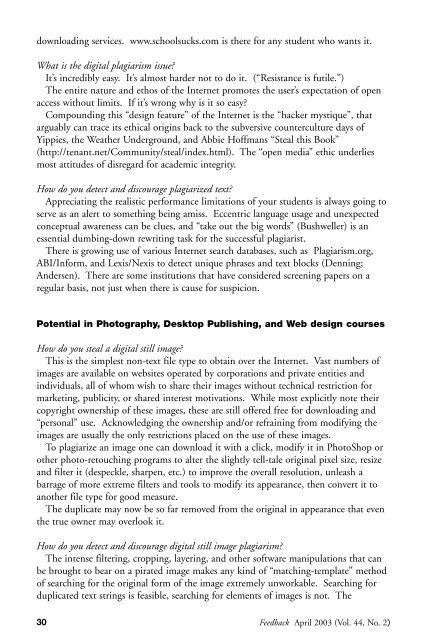APRILFeedback
Feedback April 2003 (Vol. 44, No. 2) - Broadcast Education ...
Feedback April 2003 (Vol. 44, No. 2) - Broadcast Education ...
- No tags were found...
You also want an ePaper? Increase the reach of your titles
YUMPU automatically turns print PDFs into web optimized ePapers that Google loves.
downloading services. www.schoolsucks.com is there for any student who wants it.What is the digital plagiarism issue?It’s incredibly easy. It’s almost harder not to do it. (“Resistance is futile.”)The entire nature and ethos of the Internet promotes the user’s expectation of openaccess without limits. If it’s wrong why is it so easy?Compounding this “design feature” of the Internet is the “hacker mystique”, thatarguably can trace its ethical origins back to the subversive counterculture days ofYippies, the Weather Underground, and Abbie Hoffmans “Steal this Book”(http://tenant.net/Community/steal/index.html). The “open media” ethic underliesmost attitudes of disregard for academic integrity.How do you detect and discourage plagiarized text?Appreciating the realistic performance limitations of your students is always going toserve as an alert to something being amiss. Eccentric language usage and unexpectedconceptual awareness can be clues, and “take out the big words” (Bushweller) is anessential dumbing-down rewriting task for the successful plagiarist.There is growing use of various Internet search databases, such as Plagiarism.org,ABI/Inform, and Lexis/Nexis to detect unique phrases and text blocks (Denning;Andersen). There are some institutions that have considered screening papers on aregular basis, not just when there is cause for suspicion.Potential in Photography, Desktop Publishing, and Web design coursesHow do you steal a digital still image?This is the simplest non-text file type to obtain over the Internet. Vast numbers ofimages are available on websites operated by corporations and private entities andindividuals, all of whom wish to share their images without technical restriction formarketing, publicity, or shared interest motivations. While most explicitly note theircopyright ownership of these images, these are still offered free for downloading and“personal” use. Acknowledging the ownership and/or refraining from modifying theimages are usually the only restrictions placed on the use of these images.To plagiarize an image one can download it with a click, modify it in PhotoShop orother photo-retouching programs to alter the slightly tell-tale original pixel size, resizeand filter it (despeckle, sharpen, etc.) to improve the overall resolution, unleash abarrage of more extreme filters and tools to modify its appearance, then convert it toanother file type for good measure.The duplicate may now be so far removed from the original in appearance that eventhe true owner may overlook it.How do you detect and discourage digital still image plagiarism?The intense filtering, cropping, layering, and other software manipulations that canbe brought to bear on a pirated image makes any kind of “matching-template” methodof searching for the original form of the image extremely unworkable. Searching forduplicated text strings is feasible, searching for elements of images is not. The30Feedback April 2003 (Vol. 44, No. 2)
















